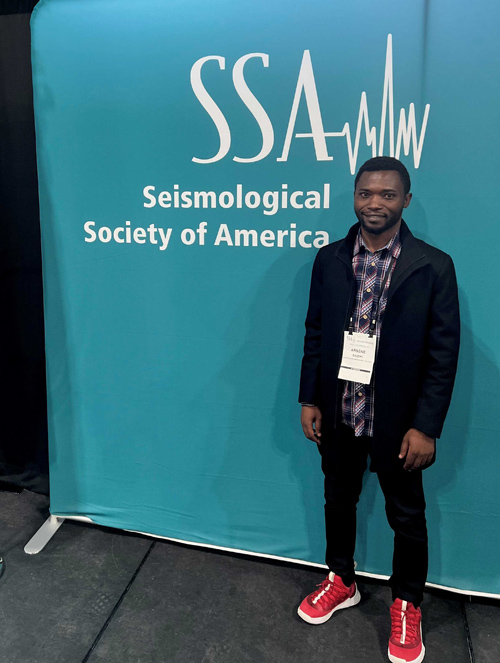29 July 2024–In the spring of 2024, Arsène Sadiki traveled from Goma Volcano Observatory (GVO) to share his research on the seismic precursors to the May 2021 eruption of Nyiragongo volcano. This volcano in the Democratic Republic of Congo once played a significant role in Sadiki’s career choice, he recalled.
“I remember in 2002, when I was in primary school, Nyiragongo erupted. Following the media coverage, I quickly felt the need to understand these phenomena,” said Sadiki. “And in 2008, a major earthquake shook the region, which pushed me to study geology to better understand Earth sciences.
 “My interest in seismology particularly developed in my fourth year of university during a visit to the Goma Volcano Observatory as part of our volcanology course, where we had an in-depth tour of the seismology department,” he added.
“My interest in seismology particularly developed in my fourth year of university during a visit to the Goma Volcano Observatory as part of our volcanology course, where we had an in-depth tour of the seismology department,” he added.
Monitoring Nyiragongo is now one of Sadiki’s responsibilities as scientific researcher at GVO. “One of Nyiragongo’s distinguishing features is its extremely fluid lava, which is rich in alkali elements such as sodium and potassium. This composition allows the lava to flow very quickly, reaching speeds of up to 60 kilometers [37 miles] per hour,” he said. “The 2002 eruption was particularly devastating, resulting in significant loss of life and displacement of communities due to fast-moving lava flows.”
Along with his own research projects, Sadiki’s daily tasks at GVO include analyzing seismo-volcanic and tectonic activity in the Virunga region and compiling a weekly bulletin from all GVO departments to summarize the status of active volcanoes and regional tectonic activity for government authorities and the media.
Monitoring Nyiragongo is important because it looms close to the city of Goma, with a population of over 2 million people, Sadiki said. “Monitoring helps scientists and authorities to detect signs of increased volcanic activity early, assess potential hazards such as lava flows and gas emissions, and issue timely warning to protect lives and property.”
One of the most striking features of Nyiragongo is a persistent lava lake within its summit crater, he explained. “The lava lake has been a subject of scientific interest and monitoring due to its dynamic behavior and potential for sudden changes that could affect nearby communities.”
Sadiki also spent eighteen months training at Italy’s Istituto Nazionale di Geofisica e Vulcanologia. He keeps up with advances in his fields of volcano seismology and geophysics through a variety of activities, despite a lack of funds and the long distances separating him from most scientific conferences. He regularly attends free online tutorials and workshops and seeks out collaborations with experts to establish a research network in the DRC.
“I’m also trying to figure out how to attend or follow online some of the scientific conferences and meetings where researchers present their latest findings,” Sadiki said. He was awarded an International Travel Grant to attend the 2024 SSA Annual Meeting.
“My greatest and enduring dream is to find an opportunity to enroll in a degree program,” he said. “I aspire to study and enhance my skills to develop models and algorithms that can more accurately predict earthquakes, volcanic eruptions, and other natural disasters.”
With the potential dangers of Nyiragongo always in his mind, Sadiki is also “eager to establish a team dedicated to educating the local population,” he said. “This team would focus on conducting educational seminars in schools, universities and public venues. Our sessions would cover essential topics on living near volcanoes and include the distribution of illustrative models to participants. Despite the critical need, there is currently no such initiative in Goma.”
SSA At Work is a monthly column that follows the careers of SSA members. For the full list of issues, head to our At Work page.
